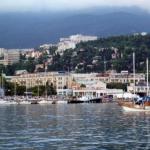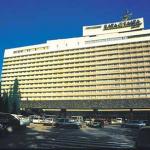Sights Yalta, Ukraine
 The sea at Yalta - a magnificent, tender and majestic. Yalta is impossible to imagine without the sea. It came into her life and gave her a name. This colorfully tells the legend "How did Yalta."
The sea at Yalta - a magnificent, tender and majestic. Yalta is impossible to imagine without the sea. It came into her life and gave her a name. This colorfully tells the legend "How did Yalta."Yalta - a sea gate of the Southern coast of Crimea, Ukraine international port. (In Ukraine there are three international maritime station Odessa, Yalta and Mariupol) In port stop-distance passenger vessels, pleasure boats and yachts. From here you can get boats in villages satellites Gurzuf, Alupka, Mishor and Simeiz. Modern Marine Station was built in 1957-1958. by architect Bronnikov. From the port in the city center displays the street. them. FD Roosevelt, one of the oldest in Yalta. The bridge thrown over the river's swift (Derekoika), connects it to the quay. Lenin.
Embankment with the adjacent area of them. Lenin constitute the city center. In the center of the square - the monumental statue VI Lenin opened in 1954 by the monument - Ukrainian sculptor PP Yatsyna. Quay - favorite place to walk yaltintsev and vacationers. It is always lively, especially in the evening. Holiday-makers here implies a warm and calm sea, the clean crisp air. Beautiful lighting lamps, the lapping waters create the illusion that this is not the street and aboard an ocean liner.
In the city park next to the waterfront hid cozy urban Theater. Chekhov. The first building of the city theater was built in 1886 It was a one-story, light, mostly wooden structure with a small stage and close the auditorium. In 1896 it was attached to the new. In April 1900 the Moscow Art Theater has given in this building, eight plays, including Chekhov's "Seagull" and "Uncle Vanya". "It was a spring in our theater, - recalled Stanislavsky - the most fragrant and happy period of his young life: We said to ourselves:" Anton Pavlovich could not come to us because he was sick, so we go to him, so as we are healthy. If Mohammed does not go to the mountain, the mountain come to Mohammed: "The performances attended by Chekhov, Gorky, Mamin-Siberian, Kuprin, Bunin, Stanyukovich, Garin-Mikhailovsky and other writers. Autumn of 1900 the theater building was burned down, and in 1908 at the same location was built new, this time of stone building. After World War II by the garden city of the theater was built portico and expanded the second floor foyer.
Botkinskaja trail was laid in the second half of last century, the outstanding Russian physician-therapist SP Botkin. The trail leads from the camping area, that a field of fairy tales, to the top Stavry-Kai, towering above Yalta. More than 7 km road is a dense forest. Around the middle of the trail at the waterfall Yauzlar, we can halt and reared in the crease of the stone to take a cold bath. But this procedure is useful only for healthy people. These days, a route of ascent for Botkin path from the Pioneer Garden (elevation 25 m above sea level). Then the route goes through the park, the streets of Lomonosov Moscow State University, Biryukova, along Wuchang-Suu river, past vineyards and in the bypass road goes to the clearing of fairy tales, to mark 117 m. If this segment of road and 2750 m Botkin added on to the path, the total distance it be 10 km.
The collection of the Nikita Botanical Gardens There are about 30 thousand species, varieties and hybrids of plants. In an amazing, beautiful, rich and interesting to its green decoration alleys annually travels more than 700 thousand tourists and tourists from all corners of the earth. Nikitsky garden has extensive research links with 550yu institutions from 80 countries worldwide.
History of Yalta.
The land on which stands Yalta, was populated by man long ago. Current Yalta grown locally Tavrskie settlement, which existed in the I century BC. e. in the former village of Chekhov. Near the city, archaeologists have found items from the Stone and Bronze Ages. In the old part of Yalta, on the slope Polikurovskogo hill on the outskirts of town, were found "stone boxes" - the burial Tauri, the oldest inhabitants of the southern coast. Time habitats Tauri in the Crimea dates back to the X-IX century BC. e. to III century BC. e. In the written sources of the Greek authors, the tribe has a bad reputation for cruel pirates, who not only rob travelers, but also sacrifice them to their virgin goddess. But, of course, piracy is for the brand was not the basis of the economy, but only "subsistence fishing". Funds for the life they gave the animal husbandry, farming, hunting, fishing and dolphins, the collection of marine molluscs.
History Tavrskie settlements, where they formed Yalta, of course, connected with the history of Crimea. In the city during construction, often find items during the Crimean Middle Ages. In the Middle Ages there was quite a large village which is called Dzhalitoy. The earliest mention of Yalta (Jalil) occurs in the description of the Crimean coast in the early twelfth century. (1145). In the XIII century on the southern coast penetrate the Venetians, and then the Genoese. Documents and maps of the fourteenth century. Yalta called YALITA, Kallitoy, Gialitoy and Etalitoy.
Since the beginning of the XV century Yalta with other southern coast land was part of the feudal principality of Theodoro, populated by people of professing Christianity. Then proceeded to Genoa, and later, until 1475, once belonged to Theodore.
From 1475 to 1774 Yalta was a province, who was in personal possession of the Turkish sultan. During this period, she fell into decay and by the end of XVIII century was a small fishing village - a few miserable huts and a church. It was located at the bottom of Polikurovskogo hill on Cape John (now it is occupied by the Marine Station).
